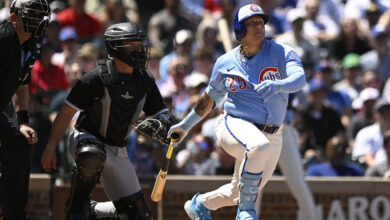
Cubs Almost Certainly Have 2021 in Mind as Draft Looms
Even though tonight’s draft takes place in the year 2019, potential departures in 2021 are already casting a shadow over the Cubs’ decisions. Barring a few extensions, Anthony Rizzo, Kris Bryant, Javy Báez, Kyle Schwarber, and a few others could see their time as Cubs come to an end. Even if the new Marquee Network brings in loads of cash, the Cubs are not going to be able to sign all of them to long-term deals.
Last year‘s draft has the potential to yield two or three position players to a new core and tonight‘s could do the same. But the current 25-man roster does not have include a player drafted after 2014, so it’s going to take more than a few draft picks to build a second core over these next two seasons.
After spending 2016 and ’17 selecting almost 50 pitchers, the Cubs went back to hitting last year and chose bats with four of their first five picks. They will likely stick with that same strategy again this time, in part because it’s a really weak class for pitchers and the position-player depth offers more value.
As such, the Cubs should be able to get players at picks 27 and 64 who project similarly to Nico Hoerner last year. Last year’s second round pick, Brennen Davis, has been extremely impressive in his short run at South Bend, offering further proof that quality bats can be found outside the first round
But with a system largely devoid of power, the Cubs may look for heavy hitters with their top two picks. It’s no secret that I like Kody Hoese of Tulane at No. 27. When number 64 rolls around, I’m hoping Drew Mendoza of Florida State will still be available. They could also go with a prep hitter, something they’ve stayed away from since taking Albert Almora Jr. sixth overall in 2012. What matters most is that they get a player who’ll have an impact in Chicago within four years.
The problem with drafting at the back of the first round is that the pickings are slim for impact players, but the Cubs have a little time to let less-heralded prospects develop. Missouri’s Kameron Misner could be one, so could Campbell’s Seth Johnson. But as the Cubs have shown time and time again, hitters are much more projectable and it’s easier to develop them while spending money on pitching.
And keep in mind that the Cubs don’t have to try and do everything through the draft. There’s international free agency, trades, and the standard free agency they largely avoided this season. Developing your own players internally may be more time-consuming than free agency, but you also get to have the player for six or seven years at a fraction of the price.
And with the current core still in place for a while, the Cubs don’t need immediate impact talent. Where they go Monday night as the draft opens will shed some light on exactly where the Cubs think they need to shore up their next core.

